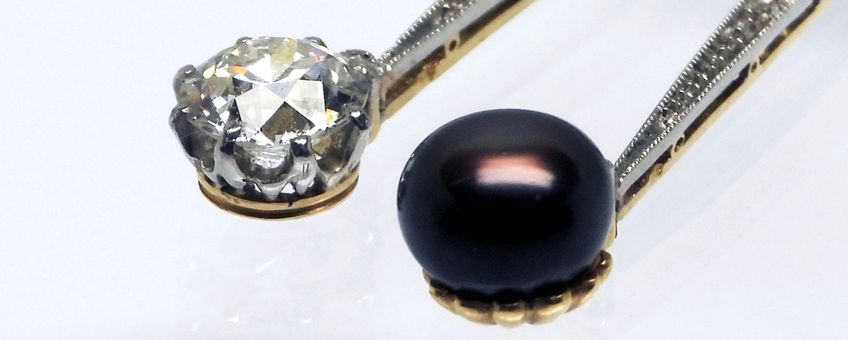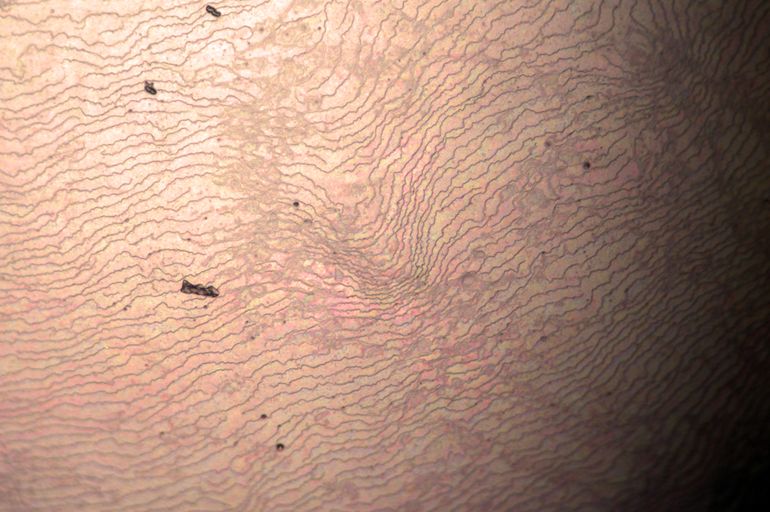
Rare black pearl discovered in Netherlands Gemmological Laboratory
Naturalis Biodiversity CenterNaturalis Biodiversity Center houses the Dutch national natural history collection. It also includes the Netherlands Gemmological Laboratory, a small group of specialists who investigate gemstones and pearls. They are led by Dr. Hanco Zwaan, who took over the position from his father. The lab does scientific research into the mineralogical collection of Naturalis but also carries out research on behalf of jewellers, auction houses, and private individuals. For example, they analyse genuineness, clarity, shape, cut, and any possible handling.
At the end of last year, Zwaan received a pendant from one of these clients with a cut diamond on one side and a dark brown to black, button-shaped pearl on the other. Although the diamond is also particularly beautiful, his attention was quickly drawn to the black pearl.
Irritated
Pearls are made up of thin layers of nacre (mother of pearl), the same substance that is present on the inside of the shell of shellfish. Pearls develop as a consequence of the mollusc being irritated inside the shell. For example, shell-boring snails regularly attack pearl oysters, damaging the mollusc’s shell and skin. The skin cells at this location could divide and form a pearl sac in which the pearl subsequently forms.

Black pearls have always been rarer than white or cream pearls. However, since the start of the last century, pearls have been cultivated increasingly often. This means that the pearl-forming mechanism of an oyster or mussel is deliberately stimulated, as a result of which they form a pearl more quickly. This technique is applied to produce both white and black pearls, so the relative rarity of such pearls is decreasing. “The majority of the black-coloured pearls that I investigate in our laboratory originate from Tahiti and are also referred to as Tahitian pearls. These pearls are mainly cultured in the oyster Pinctada margaritifera; the black colour is caused by an organic pigment especially present in this species. When I investigated the black pearl in this pendant, I was pretty surprised,” says Zwaan.
Pearl research
Zwaan used various techniques, including X-ray and laser equipment. With these, the nacre layers and the colour of the pearl can be very precisely investigated at the microscopic scale. It can also be established whether the pearl was formed in seawater or freshwater. By comparing the results with the scientific literature, something can be said about the origin of the pearl, and it can even be established whether it concerns a natural or (far less rare) cultivated pearl. Zwaan: “We quickly established that this was a seawater pearl. It was also clear that the colour of the pearl had not been artificially applied and that it was a naturally formed pearl as well. However, the results of a Raman analysis (spectroscopy using a laser) were most unusual, to say the least. The colour analyses indicated the presence of a very different pigment than that found in a Tahitian pearl.”

Salt water shellfish
Zwaan started to suspect that this was a case of an extremely rare type of pearl. He therefore contacted his French colleague Stefanos Karampelas, who had just published an article about scarcely occurring other pigments in shellfish. The colour analysis combined with the seawater origin informed them that the pearl could only have been formed in a mussel species (Mytilidae). Mytilidae species occur around the world, mainly in cold seas such as in North America and in the coastal waters of North and Northwest Europe.
However, pearls from these mussels are particularly small (less than five millimetres), and the majority are blue in colour. A pearl from a mussel species is already rarer than an oyster pearl, but especially the size and colour of the pearl in this pendant were very unusual. Zwaan and Karampelas even wrote an article about this pearl, published in The Journal of Gemmology. Hanco Zwaan: “This is a unique pearl that was probably formed in the coastal waters of the Philippines. A mussel species that is known to produce slightly larger and darker pearls occurs here. It is so unique because one hardly ever comes across a pearl formed in a mussel with this quality, colour, and size.”
More information
Article: An Unusual Black Natural Pearl from Mytilidae
Text: Sander Macquoy, Naturalis Biodiversity Center
Photos: Sander Macquoy; Hanco Zwaan; Naturalis Biodiversity Center
